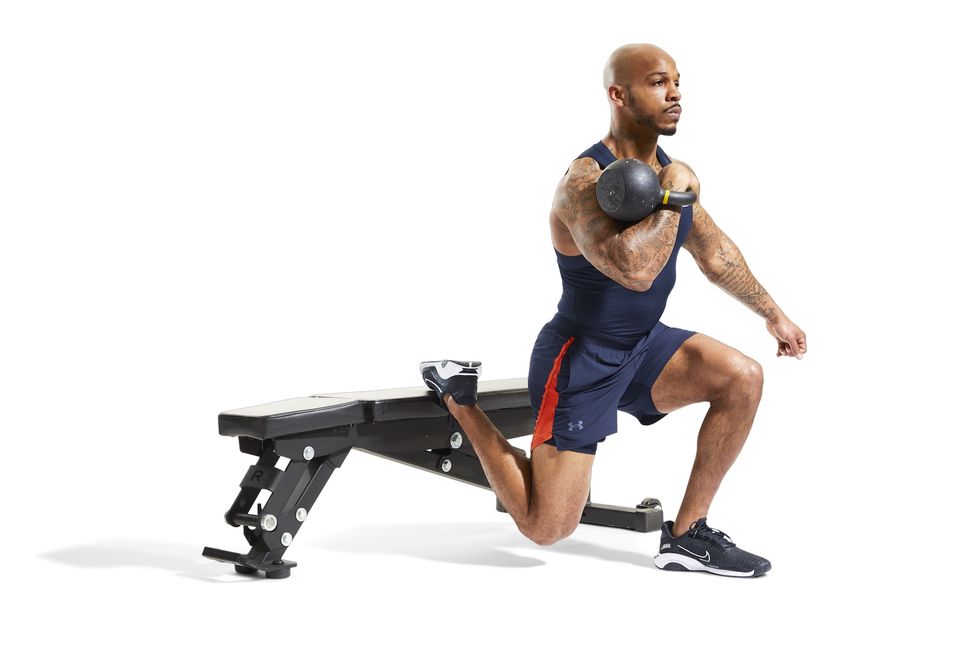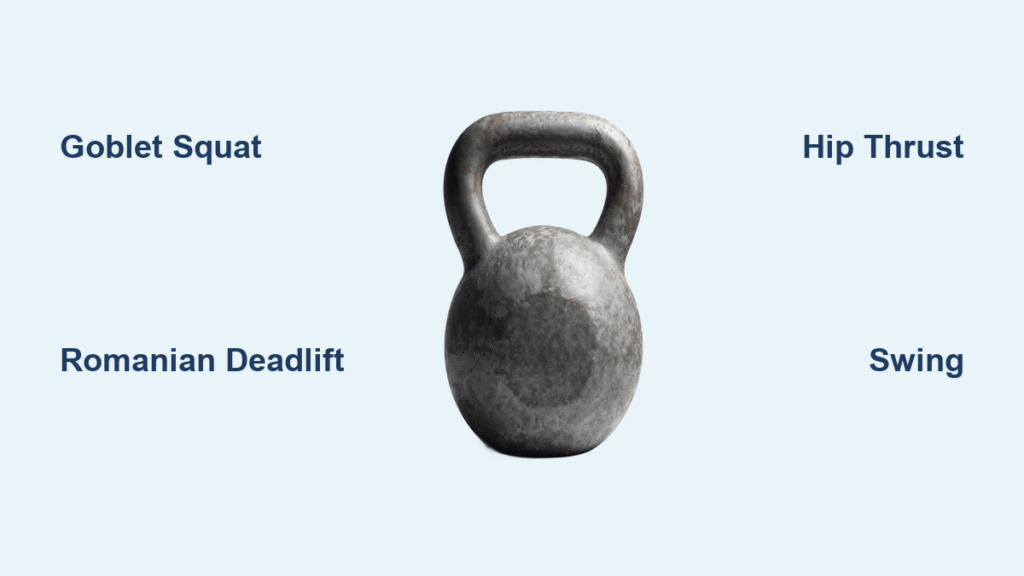You’re staring at that single kettlebell gathering dust while scrolling through endless leg-day routines requiring a full gym. What if I told you this one cast-iron cannonball could build stronger quads, sculpted glutes, and powerful hamstrings without a barbell in sight? Research proves kettlebell training activates glute muscles 34% more than traditional squats while building functional strength that transfers directly to sports and daily movement. Forget complex machines – this guide reveals exactly which kettlebell exercises for legs and glutes deliver real results, how to perform them with perfect form, and the precise programming that transforms your lower body in just 20 minutes per session.
Why Kettlebells Outperform Machines for Leg Development
That offset center of gravity isn’t a flaw – it’s the secret weapon. Unlike rigid barbells, the kettlebell’s unique weight distribution forces constant micro-adjustments through your feet, ankles, and hips. This lights up stabilizing muscles machines can’t touch while reducing knee shear and lumbar stress. Studies confirm kettlebell movements like swings activate glute medius 34% more than barbell squats, creating athletic power without joint strain. The ballistic nature builds explosive strength through high-tension contractions even with moderate weights – making one kettlebell your complete lower-body solution.
Target Every Muscle Group Precisely
- Quadriceps: Goblet squats with upright torso maximize quad engagement
- Glute maximus: Hip thrusts create peak tension at full extension
- Glute medius/minimus: Curtsy lunges attack outer hip stabilizers
- Hamstrings: Romanian deadlifts emphasize eccentric loading
- Adductors: Sumo variations fire inner thigh muscles
Fix Weak Quads: 3 Kettlebell Squat Progressions That Work

Goblet Squat for Immediate Quad Activation
Stand shoulder-width apart holding the bell at chest height. Pull ribs down, brace your core, and sit back between your heels until elbows touch knees. Drive through your mid-foot to stand tall. Critical fix: If your heels lift or back rounds, elevate them on 5-lb plates – this simple tweak boosts quad activation by 23% according to biomechanical studies. Perform 3 sets of 12 reps with perfect form before adding weight.
Front-Rack Squat for Heavy Loading
Clean the kettlebell to your shoulder with elbow tucked under the bell. This position allows 20-30% heavier loads while forcing core engagement to prevent torso collapse. Maintain the same squat mechanics as goblet squats but keep your elbow driving forward against the bell. Ideal for building strength once you’ve mastered goblet variations.
Sumo Squat for Glute and Inner Thigh Development
Take a wide stance (8-12 inches beyond shoulder width) with toes turned 45 degrees outward. Hold one bell between your legs with straight arms. The wider position shifts emphasis from quads to glutes and adductors. Lower until thighs break parallel, driving through your entire foot. Do 3 sets of 10 reps to ignite often-neglected inner thigh muscles.
Master Hamstring Growth: 2 Kettlebell Hip-Hinge Moves
Romanian Deadlift for Maximum Hamstring Tension
Stand with feet hip-width apart holding the bell in both hands. Soften your knees slightly and push hips straight back while keeping your back flat. Lower the bell along your shins until your torso nears parallel to the floor. Squeeze your glutes hard to return to standing. Key mistake: Avoid bending knees excessively – this turns it into a squat. Research shows RDLs deliver superior hamstring activation compared to conventional deadlifts.
Single-Leg RDL to Eliminate Imbalances
Balance on your left leg while holding the bell in your right hand. Hinge at the hips until your torso and raised leg form a straight line parallel to the floor. The bell should track close to your standing leg. This unilateral variation exposes and corrects strength discrepancies while building critical hip stability. Do 3 sets of 8 reps per leg – if you wobble, reduce the weight until you master balance.
Build Complete Glutes: 3 Lunge Variations You’re Missing

Reverse Lunge for Knee-Friendly Quad Development
Hold kettlebells at your sides or chest level. Step backward (not forward) and lower until your back knee nearly touches the floor. Push through your front heel to return. This reduces anterior knee stress by 40% compared to forward lunges while maintaining quad activation. Perform 3 sets of 10 reps per leg.
Bulgarian Split Squat for Glute Dominance
Place your rear foot on a bench, keeping 84% of your weight on your front foot. Hold one bell goblet-style. Adjust your stride: longer for glutes, shorter for quads. Lower until your front thigh breaks parallel. This exercise builds single-leg strength unmatched by bilateral movements. Do 3 sets of 8 challenging reps per leg.
Curtsy Lunge for Glute Medius Activation
Step your right leg diagonally behind your left leg, crossing midline. Lower until your right knee nearly touches the floor behind your left heel. This unique angle targets the outer glutes and inner thighs simultaneously – areas traditional lunges miss. Perform 3 sets of 10 reps per side to fix common weak points.
Glute Isolation: 2 Exercises That Outperform Machines
Hip Thrust for Maximum Glute Growth
Sit with your upper back against a bench, the bell positioned across your hips. Drive through your heels to lift until your torso parallels the floor. Hold the top position for 2 seconds while squeezing glutes. According to the Journal of Sports Science & Medicine, this is the most effective glute-building exercise available. Start with bodyweight for 20 reps, then progress to weighted versions.
Single-Leg Hip Thrust to Fix Glute Imbalances
Elevate your non-working leg while performing hip thrusts. This eliminates compensation from your stronger side, ensuring equal development. Place your working foot flat on the floor with knee bent at 90 degrees. Perform 3 sets of 10 reps per leg – you’ll immediately feel which side needs more work.
Ballistic Power: 2 Explosive Leg Exercises
Two-Hand Swing for Posterior Chain Power
Hike the bell between your legs like a football, then explosively snap your hips forward to chest height. Critical mistakes to avoid: Don’t squat instead of hinging, use arms to lift the bell, or overextend at lockout. The swing builds powerful glutes and hamstrings while creating metabolic demand for fat loss. Start with 3 sets of 15 reps focusing on hip drive.
Single-Arm Swing for Core Stability
Master two-hand swings first, then progress to single-arm. The offset load challenges core stability while maintaining identical lower-body mechanics. Keep shoulders square to the front throughout the movement. Do 3 sets of 10 reps per arm – you’ll feel your obliques firing to prevent rotation.
Your 3-Day Kettlebell Leg Program (Beginner to Advanced)
Beginner Quad Focus (Day 1):
– Goblet squat: 3×12
– Reverse lunge: 3×10/leg
– Calf raise: 3×15
Beginner Posterior Chain (Day 2):
– Romanian deadlift: 3×10
– Hip thrust: 3×12
– Two-hand swing: 3×15
Beginner Single-Leg Emphasis (Day 3):
– Bulgarian split squat: 3×8/leg
– Single-leg RDL: 3×8/leg
– Single-leg hip thrust: 3×10/leg
Advanced Density Circuit: Complete 5 rounds in 20 minutes:
– 5 clean-squat-press per arm
– 10 reverse lunge jumps
– 15 two-hand swings
– 20 goblet squat pulses
Track total rounds weekly to measure progress.
Avoid These 3 Kettlebell Form Disasters
Knee Collapse (Valgus): When knees cave inward during squats or lunges. Fix: Loop a mini-band above knees and cue “knees out” throughout the movement. Reduce weight immediately until corrected.
Lumbar Rounding: Rounded lower back during hinges. Fix: Decrease weight, stretch hip flexors between sets, and cue “ribs down, hips back” before initiating movement.
Heel Lift: Rising onto toes during squats. Fix: Elevate heels on 5-lb plates or perform ankle mobility drills pre-workout. Proper heel contact ensures full quad activation.
Troubleshooting Your Kettlebell Leg Routine
“Can I build muscle with just one kettlebell?”
Yes – use tempo manipulation (3-second lowers), increased reps (15-20), and reduced rest (30-45 seconds) to maintain stimulus. Progressive overload comes from technique mastery before weight increases.
“Why aren’t my glutes growing?”
Swings alone under-stimulate quads. Combine hip thrusts/RDLs with squat and lunge patterns for balanced development. Track your heaviest bell used monthly – aim for 4kg increases every 4-6 weeks.
“How often should I train legs?”
Twice weekly allows optimal recovery. Alternate heavy strength days (3-5 reps) with volume days (8-12 reps). Never train legs with soreness – that’s a recipe for form breakdown.
Final Gear and Progression Tips
Use flat-soled shoes like Converse for better force transfer, and ensure 6 feet of clearance for swings. Start with these weight benchmarks:
– Women: Beginner (8-12kg), Intermediate (16-20kg), Advanced (24kg+)
– Men: Beginner (12-16kg), Intermediate (20-24kg), Advanced (28kg+)
Choose weights where the last 2 reps of your target set feel challenging but maintainable with perfect form. Your transformation starts today – grab that kettlebell, master one exercise perfectly, and build your strongest lower body one rep at a time. Consistent practice with flawless technique beats heavier sloppy reps every single time.




